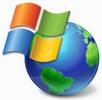 The Control Panel in Windows 7 is a great improvement over its
The Control Panel in Windows 7 is a great improvement over its 
Activating the God Mode
Calling this ‘God Mode’ is probably a bit dramatic and over the top, but what this feature does allow you to do is to create a single folder where you should be able to access everything you could ever want. The good news is that Microsoft have made is very simple to turn on this feature and create a ‘King of all Folders’.
Here’s what to do:
Create a new folder and then rename it ‘God Mode.{ED7BA470-8E54-465E-825C-99712043E01C}’. You do not actually have to use ‘God Mode’ for the initial part of the rename, you could call it whatever you want, it’s the ‘.{ED7BA470-8E54-465E-825C-99712043E01C}’ that’s important. Make sure you include the full stop “.” after your folder name and enclose the extension in curly brackets “{}”as shown. The extension must be identical to the example.
Now hit ‘Enter’ to confirm the rename and you will see that the extension has disappeared, leaving only the title that you chose for this new folder. Double-click the folder to access and you will start to see why it has been labelled ‘God Mode’.
The folder has been automatically populated with over 260 separate actions that can be accessed from this one folder. There are shortcuts to the various functions for Power Options, the Action Centre, user accounts, the Network and Sharing Centre, Windows

If you are the type of person who enjoys having total control and everything right at your fingertips, all in one handy, easily accessible place – this great little Windows 7 trick should be right up your control-freak street. The Control Panel has now finally become a ‘total control’ panel.
 Since Windows XP, multilingual computing has become considerably easier to achieve. With the Ultimate and Enterprise versions of Windows Vista and
Since Windows XP, multilingual computing has become considerably easier to achieve. With the Ultimate and Enterprise versions of Windows Vista and